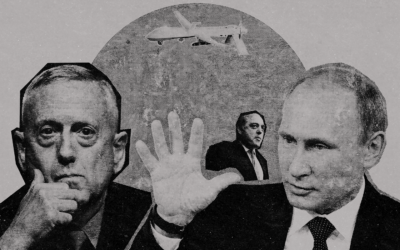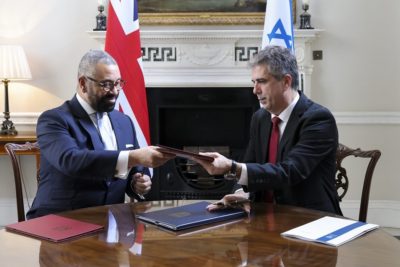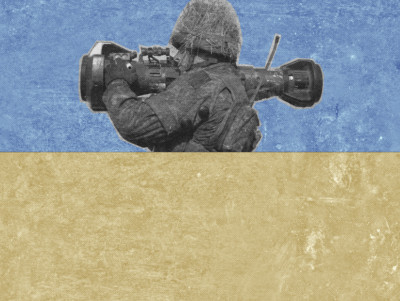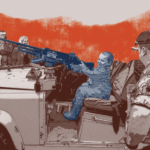Location vs Doctrine: hybrid warfare and the grey zone

In March 2021, the UK Defence Secretary Ben Wallace penned an opinion piece for the Daily Telegraph ahead of the release of his department’s Command Paper Defence in a Competitive Age. For Wallace, the paper represented the greatest shift in British defence policy since the end of the Cold War because, with the rise of China and the technology revolution, Western states were now perceiving a totally different threat landscape. If anyone wanted to understand what he meant, they only had to read the news pages of the Telegraph that day. The SAS, according to the paper’s Defence and Security Editor, were soon to deploy across the globe to disrupt “Russian meddling”. And, in what was being termed as a modern-day Battle of the Atlantic, a new spy-ship would come on line in 2024 to stop Vladimir Putin’s submarines from sabotaging underwater internet cables.
For both Wallace and the Telegraph, these moves were vital responses to the new reality of modern conflict. An era in which Britain’s adversaries were using new tactics to operate in the so-called “grey zone” between total peace and kinetic warfare. Or, as the Defence Secretary argued, those ‘aggressive actions below the threshold of open conflict’. Indeed in military and foreign policy circles, and increasingly as part of a broader public discourse, the term grey zone has seemingly come into vogue. The Sky News journalist Deborah Haynes even released a podcast series exploring the subject. But what is this contested space and who gets to define it?
Despite the spike in debate around grey zone operations, it remains difficult for non-experts to pin down precisely what is being discussed and how these different terms and concepts interplay. We have sought to understand them firstly to develop our own knowledge, but also to present an initial guide to understanding the term and its implications. What follows is a short discussion on some of the key texts, major personalities and more accessible definitions of this type of warfare that serves as a starting point in developing our knowledge.
What even is the Grey Zone?
In its simplest definition, the grey zone does in fact refer to a location – specifically a theater of conflict. The difference, however, is that this location is not necessarily geographical. Rather, it is the conceptual and operational space between peace and conventional war. Notions of risk and response are central to both the choice of locale and how operations are conducted within it. Those who operate in the grey zone are trying to operate at a level beneath that which would mandate a conventional military response. A grey zone operation is one which aims to avoid starting a hot war.
According to the UK Strategic Command – a body within the MoD that deals with joint capabilities across the armed forces and civil service – the terminology itself is a grey area:
‘The name is slightly misleading, as it isn’t a “zone” at all – at least, not one you can define geographically. The term comes from a colour-based metaphor. The idea is that a completely benign or peaceful action carried out by a group or nation can be defined as “white”. Whereas a clearly hostile action, which could be seen as an act of war, can be defined as “black”. So, with that in mind, anything between these would be “grey”. The grey zone is a murky area, consisting of everything which isn’t full-on conflict, but isn’t exactly an innocent act either’.
It is worth asking why this choice of location is made. Russia expert and transnational crime scholar Mark Galleoti, whose work on the Putin regime and forms of hybrid warfare can provide a nuanced alternative to the belligerent hot takes of US and British cold warriors, suggests the increased interdependence and interconnectedness of human society informs the choice of terrain. As he argues in his book The Weaponization of Everything:
‘It used to be orthodoxy that interdependence stopped wars. In a way, it did – but the pressure that led to wars never went away, so interdependence itself became the new battleground’.
The inference here seems to be that while there is a recognition that conventional war should be avoided, states (and non-state actors) have decided to relocate military activity below the threshold of mass state violence. It’s still potentially an act of war, but by other means and in another place. For many within the Western intelligence community, the alleged Russian influence on the 2016 US Presidential elections or Brexit referendum are a case in point. Yet, whilst the methods are different it is hard to see how this is different from CIA attempts to influence elections or bring about regime change at the heigh of the Cold War. So perhaps understandably, Galleoti goes to some lengths to confirm sub-threshold war is not at all new, using case studies from the competing Italian city-states of antiquity, while acknowledging that in many ways contemporary grey zone warfare is quite radically different.
For a tighter definition we can look at a report by the arms firm QinetiQ. Of course, it is important to critically assess anything produced by an arms firm. They are, after all, trying to sell technology to counter grey zone attacks. But their Confidence in Chaos report contains a useful explainer, one which complements and somewhat refines Galleoti’s. It suggests that the balance of power between “traditional” security and defence measures in, for example, nation-states has effectively forced war underground:
‘The supremacy of traditional security and defence systems has driven adversaries towards alternative methods’.
Grey zone approaches, they argue, include:
‘…a myriad of new threats described by multiple buzzwords, from asymmetric to hybrid and from 5th generation to sub-threshold. All these make up the “grey zone” and explore the widest range of social, political, economic and military instruments available to achieve maximum effect – but without provoking a conventional response, or even being recognised as formal acts of aggression’.
This is a form of war conducted, in a sense, without war. Or, arguably more accurately, a form of war specifically calibrated to avoid a substantial, kinetic response from the affected party. What, then, are those tactics?
Hybrid tactics
The term “hybrid warfare” is regularly used alongside grey zone, but it is important to slightly separate the two terms, while acknowledging that they do interplay substantially. A useful piece in The Converstation defines hydrid warfare, as in effect, a set of tactical and strategic doctrines:
‘Hybrid warfare is an emerging, but ill-defined notion in conflict studies. It refers to the use of unconventional methods as part of a multi-domain warfighting approach. These methods aim to disrupt and disable an opponent’s actions without engaging in open hostilities’.
Hydrid warfare, sometimes described as “political warfare”:
‘…is conducted in the “grey zone” of conflict, meaning operations may not clearly cross the threshold of war. That might be due to the ambiguity of international law, ambiguity of actions and attribution, or because the impact of the activities does not justify a response’.
What these definitions seem to suggest is a distinction between tactics and strategy – hybrid warfare is the tactics used and the grey zone is the spatio-temporal location in which it takes place. One NATO report on hybrid warfare rather captures the problem here. ‘To put it simply’, the author posits:
‘…hybrid warfare entails an interplay or fusion of conventional as well as unconventional instruments of power and tools of subversion. These instruments or tools are blended in a synchronized manner to exploit the vulnerabilities of an antagonist and achieve synergistic effects’.
Not simple at all then. As a counter to the jargonese of states, think-tanks, national militaries and governments, it’s worth attempting to lay out in plain language what hybrid tactics are and who uses them.
They can include, but are not limited to: (1) special forces and intelligence operations, up to and including sabotage and assassination; (2) lawfare, that is bringing lawsuits with so-called malign intent; (3) propaganda, including through mass media and “fake news”; (4) employing criminal gangs; (5) cyberware, including hacking attacks with an accent on financial and economic warfare; and, (6) blackmail.
It is generally held in hybrid warfare that these tactics, and more besides, are often used together synergistically to achieve a given aim. And whilst the MoD and NATO like to paint these tactics as something utilised by adversaries you don’t need to look that far back into history to see how British and American intelligence agencies (and others) have utilised such methods.
Who does hybrid warfare
Most of the debate in Britain focuses on the hybrid warfare activities of official enemies, positioning the armed forces, intelligence services and even police forces on the right side of a Manichean duality between “good” (so-called Liberal democracies) and “evil” (Russia, China, ISIS, etc). However, it should go without saying that the West is just as inclined to fight in the grey zone. But this state (or would-be state, in the case of ISIS) focus tends to ignore other actors who operate in this theater.
Returning to Galleoti, we may be able to begin to understand this as what he terms “democratized” conflict:
‘Only states can build nuclear missiles or mechanized divisions. But individuals, corporations can engage in narrative warfare, or take out a legal case, or boycott a product’.
In this analysis, anyone can engage in the grey zone. Though it would be perfectly legitimate to counter that such a sweeping definition rather muddies the water by incorporating any sort of activism, legal challenge or information campaign into a loosely defined warzone, and in doing so frames all sorts of entirely un-warlike people as witting or unwitting combatants. Isreal has been incredibly adept at this framing, labelling legal challenges (on grounds of violations of Intertnational Humanitarian Law) by NGOs and activists as a form of “lawfare” whilst also conducting counter-legal challenges themselves.
Towards a theory of origin
Whilst the tactics of hyrbid warfare are nothing new the intellectual case for hybrid warfare probably started in the late 1990s and started to gain traction around a decade later. And, as Arsalan Bilal would have it, more modern forms of hybrid warfare are less and less about lethal and kinetic force so there are differences that need conceptualisation. One prominent proponent of the theory is US marine colonel Frank Hoffman, whose 2007 essay on hybrid warfare remains influential. An example of his thinking is available in PDF form via the Small Wars Journal website, in which he argues:
‘The most distinctive change in the character of modern war is the blurred or blended nature of combat. We do not face a widening number of distinct challenges but their convergence into hybrid wars’.
Another influencial military thinker is General James Mattis, a former US marine commander and Trump-era defence chief. In a 2005 essay co-written with Hoffman the two officers describe a transition from a “three block war” – the blocks being conventional fighting, aid, and peacekeeping – to a “four block war”, during insurgencies, for example, when ideas and information become a vital front:
‘Insurgencies are wars of ideas, and our ideas need to compete with those of the enemy’.
Within the UK, the term grey-zone started to appear around a similar time. According to a search on the website of military think-tank the Royal United Services Institute (RUSI), the late Liberal Democrat politician Paul Keetch made reference to the grey-zone during a 2005 speech as defence-spokesperson for the party. However, if we look at Hansard, the written record of debates in the UK’s Parliament, the term really begins to come to prominance from around 2018 and, perhaps unsurprisingly, it is most often used when discussing Russia, China and Iran.
Going back even further, and arguably the seminal text on the topic is a book-length survey from 1999 by two Chinese military officer titled ‘Unrestricted Warfare’. It can be read free here and was published in the West with the somewhat alarmist (and rather comic) subtitle “China’s Master Plan To Destroy The World”. The original Western edition featured an image of the World Trade Centre on fire.
Beyond the hyperbole, the work is a fairly straightforward assessment of how a militarily weaker state (China) could challenge a stronger one (the US) in the context of globalization and examines some of the weaknesses of US power. The authors, Qiao Liang and Wang Xiangsu, suggest for example that the US thinks of military power primarily in technological terms, leaving it vulnerable to legal (the ‘lawfare’ mentioned above) and economic attacks.
Be wary of narratives
The key distinctions we must make are between the terrain and the tactics. For the most part, hybrid/unrestricted/sub-threshold warfare appears to describe a set of methods, while the grey zone is the location in which those tactics are employed. The aim at all times appears to be to conduct mixed military/non-military operations at a level which will not draw a conventional military response. The suggestion is that this terrain has been chosen as a result of globalization, here defined according to the fairly basic notion that globalization is a deep interconnectedness of states, non-state actors, economies and individuals globally. Yet, the notion of globalization, and the grey zone it has allegedly fostered, should be unpicked and serious questions asked around what is particularly new about these phenomenon. European colonialism was arguably an early iteration of globalization and, as we mention above, the CIA and the British intelligence services have been involved in activities that fit neatly under the rubric of the grey zone for decades. Perhaps the key difference today is the undoubted dominance of Big Tech, Big Data and the internet. Yet, while they present new opportunities for exploitation by so-called “hostile state” and non-state actors, we should be wary of a narrative that positions the British armed forces and intelligence services as the heroes and heroines protecting our world from evil.
See more: security, Grey Zone, UK Parliament, defence & foreign policy
Like what you read?
> Sign up for our newsletter or blog notifications
> Support our work – from just £2 a month










